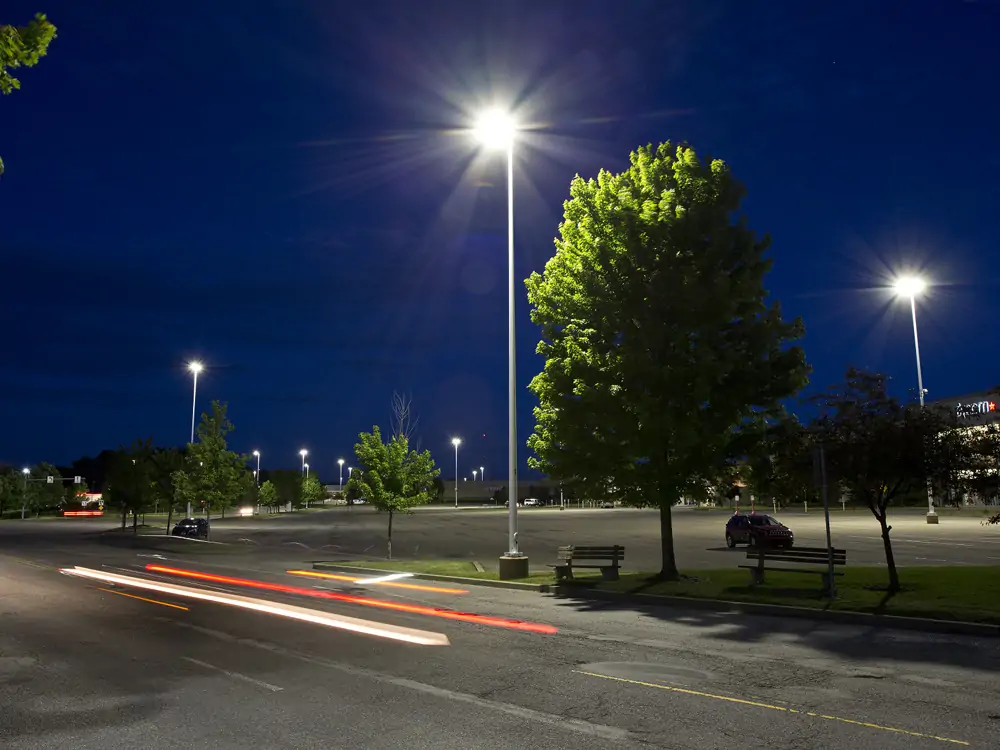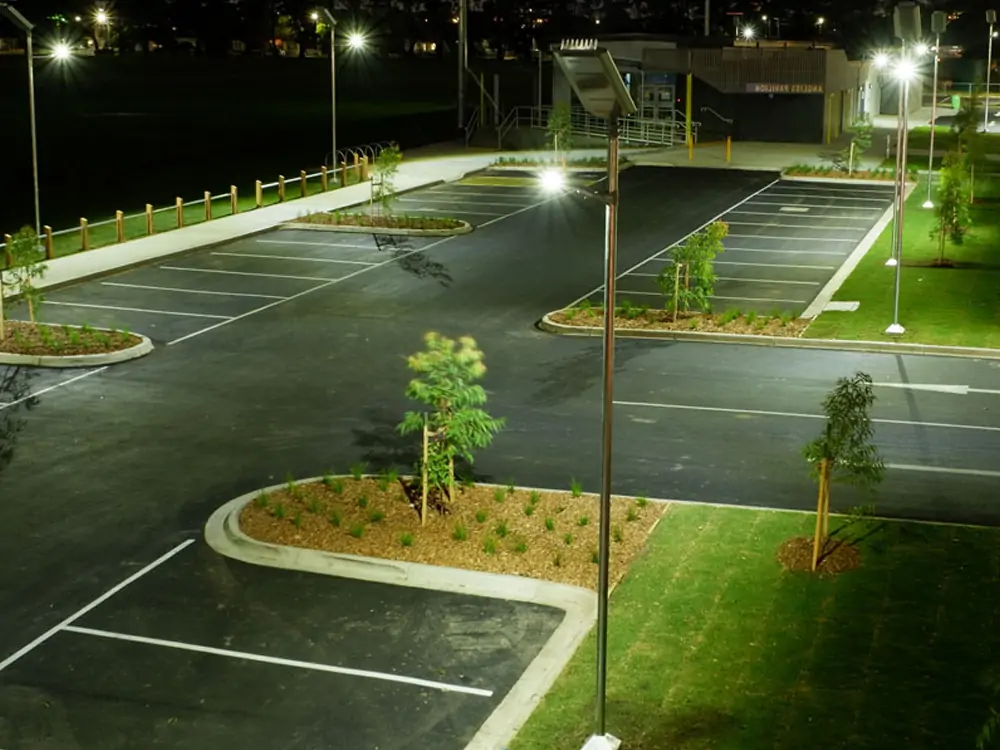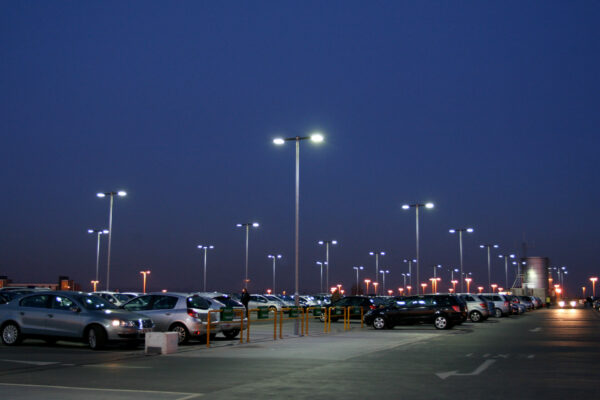Excellent LED lighting for parking lots is safer and more friendly. LED lights are efficient, durable, and perfect for outdoor use. They improve visibility and help lower crime risks. Choosing the right LED lights requires some thought. This guide will help you pick the best LED parking lot lights. Focus on quality, efficiency, and safety to create a well-lit area. Let’s explore what to keep in mind when making your decision.
Factors to Consider When Choosing Outdoor LED Parking Lot Lights
1. Size and layout of the parking lot
Start by thinking about the size and layout of your parking area lights. These factors decide your lighting needs. Watch for things like trees, poles, or buildings that might block light. Follow local rules about brightness and coverage. Think about how the lot is used. For example, retail lots need brighter lights than residential ones. Proper lighting balances safety and energy use. Overlighting wastes power, while underlighting creates risks. Plan carefully to meet all parking lot lighting requirements and improve the parking lot experience.
2. Brightness
Lumens measure how much light a fixture gives off. Higher lumens mean brighter, more even lighting. A small lot might need about 20,000 lumens per light. A large lot could need 30,000 lumens or more. Match the brightness to the size and activity of the lot. This ensures clear visibility for drivers and pedestrians. Avoid overspending on lights that are too bright. Focus on safety and proper light coverage instead.

3. Color temperature
Color temperature affects visibility and mood. It’s measured in Kelvins. Cool light, between 4,000K and 5,000K, is bright and works well in busy areas. Warm light, between 2,700K and 3,500K, creates a softer feel. Use cool tones in commercial lots to reduce accidents. Warm tones are better near homes or parks. The right choice improves both safety and comfort for users.
4. Beam angles
Beam angles decide how light spreads. Narrow angles, like 15° to 30°, focus on specific spots like entrances. Wide angles, such as 60° to 120°, cover larger areas. Light distribution patterns also matter. Type II patterns work for driveways, while Type V is best for wide, open lots. Pick the right angle and pattern to ensure even lighting without glare or waste.
5. LED light efficiency
They use up to 80% less power than older types of lighting. Features like motion sensors or dimmers help save even more. For example, dimming lights during low-use hours cuts energy costs. Efficient lights lower bills and reduce your carbon footprint. Look for models with certifications like Energy Star for top performance.
6. Color Rendering Index (CRI)
Color Rendering Index (CRI) measures how well LED lights show the true colors of objects. A higher CRI means better color rendering. For parking lot LED lights, a CRI above 80 is recommended.
7. Outdoor lights material
Choose fixtures made from strong materials like corrosion-resistant aluminum. A high IP rating, like IP65, means protection against water, dust, and bad weather. For example, snowy areas need lights that work in freezing temperatures. Durable designs reduce maintenance and keep lights working longer.
8. Control features
Control features make lighting smarter. Motion sensors turn lights on only when needed. Timers and dimmers adjust brightness throughout the day. For instance, dim lights to 50% brightness after midnight to save energy. Smart controls let you make changes remotely. These features improve safety, lower costs, and give you more flexibility.
9. Type of light
Knowing whether you are retrofitting fixtures or starting a new installation is important. Retrofitting upgrades old fixtures with LED technology. This option saves money and uses what is already in place. New installations give you more choices for design and fixtures but cost more upfront. Parking lot lighting fixtures comes in different shapes and sizes to meet various needs. Shoebox lights are great for large spaces, while wall-mounted fixtures add style. Choose fixtures that fit your parking lot LED lighting layout and needs to get the best results.
10. Cost
The cost is more than the upfront price. Think about long-term savings from lower energy use and less maintenance. High-quality parking lot lighting fixtures cost more at first but last longer. For instance, a $500 LED light with a 10-year life costs less over time than a $300 light that needs frequent replacements. Compare warranties and lifespans to find the best value.
11. Certifications
Certifications ensure quality. Look for UL, DLC, or Energy Star labels. These prove the lights meet safety and efficiency standards. Certified products follow local codes, helping you avoid fines. For example, UL means safe electrical design, and DLC shows energy efficiency. Certifications give peace of mind and ensure reliability.
Vantagens das luzes LED para parques de estacionamento

LED parking lot lights are energy-efficient and last longer than traditional options. They lower costs while providing brighter, more consistent lighting. Better visibility improves safety for pedestrians and drivers. LEDs need little maintenance, saving time and money. They are eco-friendly, reducing your impact on the environment. Choosing LEDs gives you a cost-effective and reliable solution.
Common Mistakes to Avoid
Don’t pick lights that are too dim or too bright for your needs. Follow local rules to avoid problems. Skip low-quality products that may fail early. Mistakes like these can lead to higher costs and safety issues. Plan well to get the best results.
Steps to Implement the Right Lighting Solution
First, assess the size and layout of your parking lot. Talk to experts to design a system that fits your needs. Choose reliable suppliers with certified products. Test the system after installation to make sure it works. Regular maintenance keeps the lights running and extends their life. Careful planning ensures your system is safe, efficient, and effective.
Future Trends in LED Parking Lot Lighting
When it comes to LED parking lot lights, things are changing. To take advantage of the newest technology advances and be environment-friendly and helpful, you need to stay ahead of the curve.

1. Smart Parking Lot Lighting Solutions
- IoT Integration:
The Internet of Things (IoT) will influence intelligent parking lot illumination. Central control systems can communicate with LED fixtures through sensors and connectivity. This allows for real-time monitoring, data analysis, and adaptive illumination adjustments.
- Predictive Maintenance:
Intelligent lighting systems will use predictive algorithms. These algorithms expect and schedule maintenance based on fixture performance data. This proactive approach reduces care costs. It also minimizes periods of inactivity.
- Adaptive Lighting:
LED fixtures will adjust their distribution patterns and luminance levels. These adjustments depend on environmental conditions, traffic flow, and occupancy. This enhances the user experience and improves safety. It also optimizes energy consumption.
- Integration with Parking Management:
The parking management systems will be incorporated with the illumination in the parking lot. Parking sensors will identify available spaces. It reduces congestion and diverts vehicles to vacant places.
2. Emerging Technologies
- Li-Fi Integration:
Light Fidelity (Li-Fi) technology is emerging as a potential game-changer in parking lots. It uses visible light to send data. This allows it to provide high-speed wireless internet access. In the future, LED fixtures may serve as Li-Fi transmitters. This could enable both illumination and connectivity in a single solution.
- State-of-the-Art Sensors:
Integrating sophisticated sensors into LED fixtures will improve their functionality. These sensors include technologies like radar and LiDAR. They enhance the detection and response capabilities of the fixtures. This advancement will improve security. Additionally, the sensors will enable intelligent parking management systems.
- Energy Harvesting:
Piezoelectric and photovoltaic technologies may be integrated into future LED luminaries. These systems can enhance energy efficiency by capturing and storing energy from various sources.
3. Sustainability and Environmental Initiatives
- Solar-Powered LED Lighting:
Integrating solar panels into LED fixtures will become prevalent. This innovation reduces dependence on the grid. It also improves the sustainability of parking lot illumination.
- Biodiversity-Friendly Lighting:
Lighting designs will consider the effects on local flora and fauna. Designers will prioritize minimizing disruption to wildlife. Warm-colored LED illumination will be used to reduce light pollution. This approach will help preserve natural ecosystems.
- Circular Economy:
Manufacturers will install a circular economy strategy. It involves the development of fixtures that are simple to disassemble and recycle. This fosters sustainability and minimizes waste.
- Carbon Neutrality:
Several organizations are committing to attaining carbon neutrality. LED lighting manufacturers and consumers will install energy-efficient fixtures. They will also adopt renewable energy sources to mitigate carbon emissions.
- Regulatory Compliance:
Stricter regulations about environmental impact and energy efficiency are anticipated. Adherence to these regulations will stimulate innovation in LED parking lot illumination solutions.
Conclusão
Excellent outdoor parking lot lights improves safety, efficiency, and user experience. Consider brightness, durability, and energy use when choosing your lights. Avoid common mistakes by focusing on quality and compliance. With the right planning, you’ll create a system that is reliable and cost-effective. A well-lit parking lot shows professionalism, promotes safety, and gives users peace of mind.
